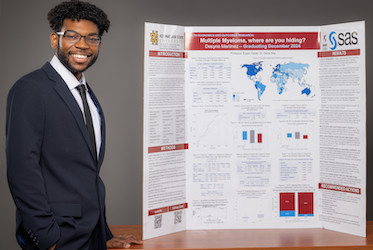
Anxiety: The Game
MARIETTA, Ga. | Feb 14, 2018
Kennesaw State students develop game to convey effects of anxiety
Growing up with anxiety, Kennesaw State junior Melissa Gilmer found it difficult to articulate what it felt like to be gripped by immense fear and stress.
Speaking to others about having anxiety didn’t adequately convey her daily struggle, nor did writing her experiences on paper. It wasn’t until she took a course in digital media and interaction that she found a platform well suited to tell her story: a game.
This past fall, she and classmate Dustin Colvin, both studying computer game design and development, used her experiences and the technical skills they acquired through the University’s Department of Software Engineering and Game Development to create “Anxiety,” a choose-your-own-adventure computer game designed to put players in situations that may induce anxiety for their on-screen character.

The situations in the game are based on those that have caused Gilmer to experience anxiety in real life. For her, stressors like school projects and experiencing new places affected her to the point that she would lock herself in a bedroom or seek out family members to cope. Often stressors were as simple as hearing a loud, unexpected noise. She recalls a time in which she heard a loud “pop” during one of her classes, causing her to lose concentration and start to worry.
Drawing from her experiences, Gilmer said she and Colvin sought creative ways to simulate what anxiety feels like using a virtual environment. For example, the game starts off in black and white, but color returns to the scenery if the player makes choices that keep the character’s anxiety levels low. Similarly, the background music goes up an octave as players encounter stressful situations.
“If you experience a lot of stress over a short period of time, the scenery begins to distort and wobble,” Gilmer said. “You know how the world looks, but when you’re stressed, the world does not look the same to you anymore. Everything looks worse. The thing about anxiety is, normal things can turn on their heads at a moment’s notice.”
“Anxiety” was purposely built to be simple, the designers say. It uses just one character – a nameless woman – moving through three levels. The first level is set in the fictional town of Haven. Other levels include a forest and a plains area, where the character’s home can be found. Players navigate the character past alleyways, abandoned cars and storefronts using their keyboards, and certain locations in each level will trigger dialogue boxes that are classified as either an “event” or “memory.”
Events are revealed in a series of text prompts describing a situation, which calls for a response from the player. One event, for example, involves hearing a noise coming from the end of an alleyway, forcing the player to decide whether to investigate or ignore the sound. Memories also appear in a dialogue box, but they are more positive encounters, which remind players that, despite their fears or anxiety, they should seek out the people and places that help them cope. Depending on how each situation is handled, the character’s stress level will rise or fall. Too much stress will abruptly end the game.

The game combines several elements covered in the Digital Media and Interaction course, including how to use virtual graphic design with programming skills to create an impactful game, said Rongkai Guo, an assistant professor of gaming. All components of the game outside of the artwork, which was outsourced to a Kennesaw State alumna, was built by Gilmer and Colvin on the Unity game platform frequently used by gaming students.
As part of the course, students were required to pitch their game ideas to their peers before learning the basics of camera and lighting design in the virtual environment. Other lectures included how to incorporate modeling, animation and artificial intelligence into their game designs. The course ends with a final project demo, during which all student groups showcase a completed version of their games.
“I was very happy to see Dustin and Melissa’s game because it uses components of digital media to represent the feeling of having anxiety,” said Guo, whose wife struggles with the disorder. “I cannot say how hard it is to cope with anxiety, and it’s difficult to understand what those afflicted are surviving because everyone with anxiety might have a different trigger. This game is designed to demonstrate some of them.”
The pair would like to take a public version of the two-dimensional game to market by March 2019, and are continuing to develop an alternate, more interactive version of the game using virtual reality. Their goal is to target educators and families who don’t necessarily grapple with anxiety but know someone who does and who might like to learn more about the disorder. According to the Anxiety and Depression Association of America, anxiety disorders are among the most common mental illnesses in the U.S., affecting more than 40 million adults.
The students’ work is also representative of a growing interest in serious and educational game design, Guo said. According to technology research group Metaari, game-based learning products reached $3.2 billion in revenue in 2017 and are expected to grow more than 20 percent by 2022. While many games currently in the larger gaming market focus on entertainment, serious and educational games concentrate on helping a more specialized demographic by creating something that isn’t otherwise available in the marketplace.
“We asked ourselves how many people we would need to help for the project feel like it was worth it, and we think it’s just one,” Colvin said. “If you’re a parent and you have a child who suffers from anxiety and you just can’t figure out why, we’re offering you a glimpse inside their head.”
– Travis Highfield
Photos by Lauren Kress; Video by Rob Witzel
Related Stories

Freshman Kennesaw State student has unprecedented success in research

Kennesaw State University to offer Master of Science in Artificial Intelligence

Dad's cancer diagnosis inspired Kennesaw State student's award-winning research

Kennesaw State receives $2.5 million grant to foster student success in calculus
A leader in innovative teaching and learning, Kennesaw State University offers undergraduate, graduate and doctoral degrees to its more than 45,000 students. Kennesaw State is a member of the University System of Georgia with 11 academic colleges. The university’s vibrant campus culture, diverse population, strong global ties and entrepreneurial spirit draw students from throughout the country and the world. Kennesaw State is a Carnegie-designated doctoral research institution (R2), placing it among an elite group of only 7 percent of U.S. colleges and universities with an R1 or R2 status. For more information, visit kennesaw.edu.















